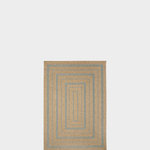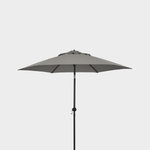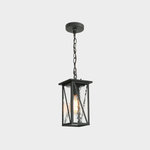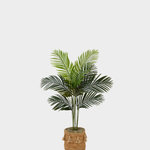Key Measurements for Planning Your Outdoor Furniture Layout
Learn how much space you need for al fresco dining and seating to ensure a comfortable and inviting outdoor living space
Summer has arrived, and it’s time to move indoor living outside. If your outdoor space needs some love, it may also be time to invest in some new patio furniture. When adding new pieces, be sure to leave enough room for the furniture and for people to move between various entertaining or relaxing areas. Otherwise, your outdoor living space may feel more cramped than inviting.
Read on for some simple guidelines on determining just how big or small that new outdoor dining table should be, exactly how much space you have for a love seat or sofa and how far your seating should be from your fire pit.
Read on for some simple guidelines on determining just how big or small that new outdoor dining table should be, exactly how much space you have for a love seat or sofa and how far your seating should be from your fire pit.
Design for traffic flow. Determine how you want people to access the various areas of your yard. Consider where you enter the yard, either from the house or through a gate. Choose the best way to reach or pass through various areas, from a patio with a table, seating and maybe a grill to a secondary seating area or a pool or spa.
Allow at least 3 feet of clearance in areas that will get a lot of foot traffic, although 4 feet or even slightly more is preferred, says Amy Martin of Amy Martin Landscape Design in Cohasset, Massachusetts. You can go slightly smaller for a simple garden path that won’t get as much back-and-forth use. “A 2-foot or 2½-foot path makes you slow down and be mindful,” she says.
Find a landscape designer in your area
Allow at least 3 feet of clearance in areas that will get a lot of foot traffic, although 4 feet or even slightly more is preferred, says Amy Martin of Amy Martin Landscape Design in Cohasset, Massachusetts. You can go slightly smaller for a simple garden path that won’t get as much back-and-forth use. “A 2-foot or 2½-foot path makes you slow down and be mindful,” she says.
Find a landscape designer in your area
A little more walkway space is also a good idea for safety’s sake around a grill or a swimming pool. A 4-foot clearance between the front of a grill and any other furniture gives the cook and others enough room to work. A 5-foot walking area around an in-ground swimming pool gives people plenty of room to maneuver without risking going into the water.
Need a pro for your home remodeling project?
Let Houzz find the best pros for you
Let Houzz find the best pros for you
Add the comforts of home. You’ll want to think about how you want to use the different areas of your yard. “Approach the furniture layout as you would for your living room or family room,” says interior designer Kerrie Kelly of Kerrie Kelly Design Lab in Sacramento, California. She recommends incorporating side tables and coffee tables, chairs and ottomans, as well as rugs, accessories and art to complete your outdoor living space.
Outdoor Dining Setups
Having a place to sit and dine, with at least enough room for a snack or a drink, can be an ideal setup for an outdoor space.
Compact dining areas. If you’re limited on space, a bistro table and a chair or two may be your best choice for an outdoor dining setup. Bistro tables are usually only 2 to 3 feet wide. Even when you add in chairs and at least 2½ to 3 feet for circulation, you can fit a bistro table and two chairs into a space that’s 6 by 8 feet.
Having a place to sit and dine, with at least enough room for a snack or a drink, can be an ideal setup for an outdoor space.
Compact dining areas. If you’re limited on space, a bistro table and a chair or two may be your best choice for an outdoor dining setup. Bistro tables are usually only 2 to 3 feet wide. Even when you add in chairs and at least 2½ to 3 feet for circulation, you can fit a bistro table and two chairs into a space that’s 6 by 8 feet.
Larger dining spaces. For a larger dining area, Martin recommends calculating the size of the table with the chairs pushed in: length and width for a rectangular table and diameter for a round table. Then allow an extra 3 feet of space on all sides to determine the amount of floor space you’ll need. “This gives you room to pull the chairs out and still let people get by,” she says.
Shop for outdoor dining furniture on Houzz
Shop for outdoor dining furniture on Houzz
Are you worried that the right-size table for your needs might feel a bit cramped, especially at each end? “Look for an oval table, or a rectangular table with rounded edges at each end,” says Justin Aulakh of Classic Patio Furniture in Redwood City, California. The softer edge provides a few extra inches of space to move around. “The rounded edge also is more comfortable if you want to add a couple extra people at the ends of the table,” he says.
Another tip from Aulakh is to use swivel chairs to save some room. They don’t need to be pulled out very far, if at all, to let people get in and out.
Another tip from Aulakh is to use swivel chairs to save some room. They don’t need to be pulled out very far, if at all, to let people get in and out.
Seating Areas
Next on the list for most yards is a place to sit and relax. Your choices range from simple chairs and chaise lounges to sofas and love seats — even swings and gliders. Most outdoor chairs, sofas and love seats are the same depth as their indoor counterparts. Deep-seat options, which some people might prefer for their patio pieces, are slightly deeper to encourage relaxation.
Next on the list for most yards is a place to sit and relax. Your choices range from simple chairs and chaise lounges to sofas and love seats — even swings and gliders. Most outdoor chairs, sofas and love seats are the same depth as their indoor counterparts. Deep-seat options, which some people might prefer for their patio pieces, are slightly deeper to encourage relaxation.
Chairs. Plan on allowing 3 square feet for most chairs. If the chairs recline or have a slanted back, such as Adirondack chairs, be sure to include that in your measurements. You’ll also need to allow space for a built-in footrest or a footstool if you have one.
If you opt for deep-seat options, which usually run 34 to 42 inches deep rather than the more conventional 28 to 30 inches deep, you’ll need to accommodate the extra space required.
If you opt for deep-seat options, which usually run 34 to 42 inches deep rather than the more conventional 28 to 30 inches deep, you’ll need to accommodate the extra space required.
Chaise lounges. Chaise lounges are usually around 80 inches long and 24 inches wide. You’ll want to allow enough room to access the chaise from at least one side — at least 24 inches, though 36 inches would be more comfortable.
Maybe leave room — at least 18 inches — for a small table on one side. Chaise lounges are made for relaxing, so a nearby table means you won’t need to get up for a spell.
Browse chaise lounges
Maybe leave room — at least 18 inches — for a small table on one side. Chaise lounges are made for relaxing, so a nearby table means you won’t need to get up for a spell.
Browse chaise lounges
Outdoor sofas and love seats. Outdoor sofas and love seats give you flexible seating for several people. Just like their indoor counterparts, they’re a gathering spot for relaxing, chatting and maybe even watching an outdoor movie.
Both seating options come in a range of sizes, but a love seat is usually between 52 and 60 inches long, while sofas range from 70 to 94 inches long. The standard depth for both is 30 to 32 inches, but the deeper options are 34 to 42 inches deep.
Both seating options come in a range of sizes, but a love seat is usually between 52 and 60 inches long, while sofas range from 70 to 94 inches long. The standard depth for both is 30 to 32 inches, but the deeper options are 34 to 42 inches deep.
Porch swings. When it comes to relaxing, there’s really nothing like the allure of a porch swing. A 2-foot-long swing will hold one person; one that’s 6 feet long can hold three to four people. When deciding on how large your swing should be, also plan for 14 to 16 inches on each side. Most swings are about 30 inches deep.
In addition to allowing for length and depth, you’ll also need to allow for the arc of the swing. Plan for about 4 feet in back and 5 feet in front.
How to Hang a Porch Swing and Get Your Relaxation On
In addition to allowing for length and depth, you’ll also need to allow for the arc of the swing. Plan for about 4 feet in back and 5 feet in front.
How to Hang a Porch Swing and Get Your Relaxation On
Gliders. Outdoor gliders provide the relaxing sway of a porch swing or rocker on a solid and stable base. A glider can hold three or four people, depending on size. Most people opt for a glider that is 4 to 5 feet wide and will comfortably hold two people. Gliders are usually about 30 inches deep. The finished size will depend on the design.
Although their movement is generally less than that of a swing, gliders still need to sit at least 30 inches away from the wall behind them, with a foot or two in front for easy access. It’s also a good idea to plan for about 14 to 16 inches on each side of the glider as well, so it isn’t crowded in its space.
Although their movement is generally less than that of a swing, gliders still need to sit at least 30 inches away from the wall behind them, with a foot or two in front for easy access. It’s also a good idea to plan for about 14 to 16 inches on each side of the glider as well, so it isn’t crowded in its space.
Hammocks. A hammock set under a tree encourages outdoor lounging. The most popular options are single and double hammocks, although you can find larger ones. Hammocks usually measure about 74 to 79 inches long. Single hammocks are 39 to 60 inches wide, while double hammocks are 72 to 84 inches wide.
The anchors for a hammock should be 10 to 15 feet apart. You’ll want the hammock itself to hang about 18 inches above the ground when occupied. Tying a hammock between trees is a time-honored approach, but anchor bolts and even some straps can cause long-term damage to the trees themselves. If you do opt for straps, use tree straps.
Other options include anchoring your hammock to two posts or using a hammock stand. Before you get started, make sure your supports can handle the weight of a person or two.
Pick the Right Hammock for Summer Lounging
The anchors for a hammock should be 10 to 15 feet apart. You’ll want the hammock itself to hang about 18 inches above the ground when occupied. Tying a hammock between trees is a time-honored approach, but anchor bolts and even some straps can cause long-term damage to the trees themselves. If you do opt for straps, use tree straps.
Other options include anchoring your hammock to two posts or using a hammock stand. Before you get started, make sure your supports can handle the weight of a person or two.
Pick the Right Hammock for Summer Lounging
Accent Tables and Fire Pits
A small table next to a chair, chaise lounge or sofa should be within easy reach, much like a side table inside your home. Martin recommends allowing 24 inches between a coffee table and a sofa, love seat or chairs. “It’s enough room for people to move in and out, and close enough to keep it cozy and to be close to your drinks and nibbles without having to stand up,” she says. Side tables can be closer, as you usually don’t need to move past them to get into a chair or sofa.
A small table next to a chair, chaise lounge or sofa should be within easy reach, much like a side table inside your home. Martin recommends allowing 24 inches between a coffee table and a sofa, love seat or chairs. “It’s enough room for people to move in and out, and close enough to keep it cozy and to be close to your drinks and nibbles without having to stand up,” she says. Side tables can be closer, as you usually don’t need to move past them to get into a chair or sofa.
A distance of about 18 to 24 inches between a fire pit and the seating area is also ideal, giving you plenty of room to get into the seating area without getting too close to the flames. “You can always pull the seating closer if you want more warmth or move it away if it gets too hot,” Aulakh says.
More on Houzz
Set Up Your Patio for Ultimate Lounging — Whatever Its Size
The Best Materials for Your Patio Furniture
Browse landscape photos
Find a landscape contractor
Shop for your outdoor spaces
More on Houzz
Set Up Your Patio for Ultimate Lounging — Whatever Its Size
The Best Materials for Your Patio Furniture
Browse landscape photos
Find a landscape contractor
Shop for your outdoor spaces


















Measure your space. Before you buy, consider pulling out a rope, string, tape or chalk to mark off the different furniture pieces and desired layout to make sure everything will fit in your space. Good quality patio furniture can last two or three decades, so it’s wise to take some time to choose a setup that will work for you.